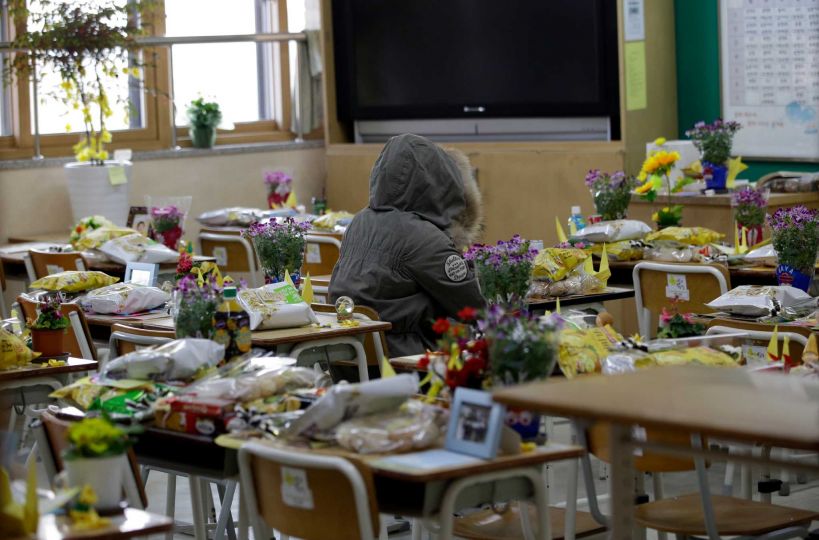- California Assembly OKs highest minimum wage in nation
- S. Korea unveils first graphic cigarette warnings
- US joins with South Korea, Japan in bid to deter North Korea
- LPGA golfer Chun In-gee finally back in action
- S. Korea won’t be top seed in final World Cup qualification round
- US men’s soccer misses 2nd straight Olympics
- US back on track in qualifying with 4-0 win over Guatemala
- High-intensity workout injuries spawn cottage industry
- CDC expands range of Zika mosquitoes into parts of Northeast
- Who knew? ‘The Walking Dead’ is helping families connect
Classrooms remain shrines for Sewol victims until ‘spiritual graduation’

In this picture taken on Wednesday, April 8, 2015, an alumna sits in a victim’s chair inside a classroom at Danwon High School in Ansan, south of Seoul, South Korea. One year ago the ferry Sewol carrying 325 second-year students on a field trip to a southern island sank; only 75 survived. Their classrooms in this city about an hour south of Seoul have barely changed from the day they left for the trip. (AP Photo/Lee Jin-man)
ANSAN, South Korea (AP) — Surrounded by the buzz of regular school life, a few classrooms at Danwon High School stand apart. They have become part shrine, part refuge, part confessional.
One year ago a ferry carrying 325 second-year students on a field trip to a southern island sank; only 75 survived. The classrooms in this city about an hour south of Seoul have barely changed from the day the students left for the trip.
A dusty piece of paper pinned to a bulletin board shows school meals for that month. The daily cleaning checklist, where each student showed with a colored dot when they’d completed a task, stops at April 14, two days before the sinking.
Outside the classrooms, as the light from the late afternoon sun fades, the school is flooded with messages, letters and gifts from the city of Ansan, the country and the world. No window or wall escapes scribbled notes, Post-its, letters. The hallway is filled with boxes of small paper cranes, yellow ribbons and huge papers with messages of sadness and grief — a shrine for the dead teachers and students, most of whom waited inside the sinking ferry for help or instructions while the ship’s captain and crewmembers escaped to a coast guard rescue boat.
A banner on the school gate reads: “I will never forget you.” Yellow banners are tied to the trees lining the roads outside the school, each with messages from parents who lost children.
Despite the examples of grief, the school and students seem to have found a way to coexist with the memories of those who died, even to have embraced the painful past. What may look morbid to outsiders — empty classrooms with flowers, letters and gifts for the dead students — is part of these students’ school life, a place where they can go for a quick catch-up with friends, a place they once shared with those who’ve died.
Outside, the setting sun filters through the paper-thin pink and white blossoms of the cherry trees. A boy in a uniform sits under a tree with his hands in his pockets, whispering something to a girl standing nearby. They ignore visiting TV cameras, an intrusion they’ve grown used to since the sinking captured the nation’s attention a year ago.
In one of the preserved classrooms, four boys sit at one desk with their heads together, going over something intently. They once studied here as well; they are among the survivors of the sinking and have recently entered their third year at Danwon.
As one stands up and walks to a teacher’s podium to place an envelope there, the others pick up their backpacks and get ready to leave.
When asked what they’re doing, one of them says simply, “It’s my classroom.”
A student who identifies herself as Soobin leaves Post-it messages each day she visits a dead friend’s empty desk, which Soobin had cleaned. One of her messages apologizes for not visiting more often. She has also left several unopened letters.
There’s a birthday cake box left unopened on one desk. Bags of potato chips and cans of soda on another. A picture of students in uniform. A plant with a note that says when it was last watered and when it will need more.
A father has left a message on a desk saying he came to try to recapture the smell of his child, but that he couldn’t feel anything. A mother left a long row of Post-it messages signed with the day of her visit.
The blackboard is covered with letters saying, “Come back” and “Hope you are warm up there.”
The classrooms of the dead will be kept this way until the students’ “spiritual graduation ceremony” next year, the school says.















